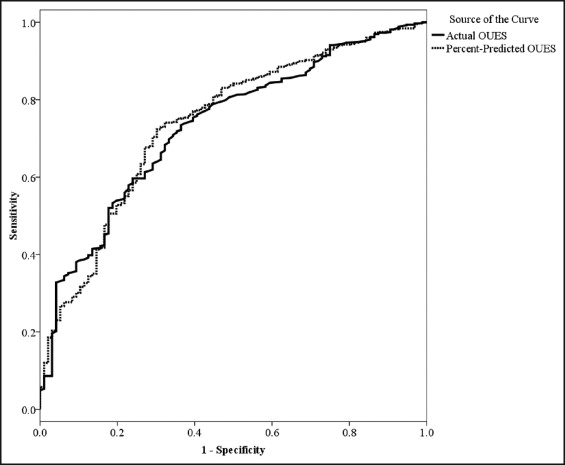The oxygen uptake efficiency slope (OUES) is a marker of ventilatory efficiency with potential prognostic value in patients with heart failure (HF). Like peak oxygen consumption (V o 2 ), the OUES is modulated by age, gender, and body habitus, creating the potential for the utility of a percentage-predicted expression. Our group recently demonstrated that a percentage-predicted expression of peak V o 2 , using the equations proposed by Wasserman and Hansen, prognostically outperformed the actual value in a large HF cohort. No previous investigation has compared the prognostic characteristics of actual and percentage-predicted OUES expressions in patients with HF. As such, the purpose of the present investigation was to test the hypothesis that a percentage-predicted expression of the OUES will provide better prognostic resolution compared to the actual value in a group of patients with HF.
Seven hundred twenty-one patients with HF (mean age 62.4 ± 13.8 years, mean ejection fraction 37.2 ± 16.1%, 82% men, 45% with ischemic HF) underwent cardiopulmonary exercise testing (CPX) to determine V o 2 and ventilatory efficiency (VE/V co 2 slope and OUES). The OUES was determined using least squares linear regression (V o 2 = a log 10 VE + b; both CPX measures are expressed as liters per minute) using spreadsheet software (Microsoft Excel; Microsoft Corporation, Redmond, Washington) using all the exercise data. Percentage-predicted peak V o 2 was determined by the equations proposed by Wasserman and Hansen. Percentage-predicted OUES values were calculated using the only male/female equations that are available. The CPX laboratories involved in the present analysis and testing procedures have been previously described. All subjects provided written informed consent, and institutional review board approval was obtained by each participating institution. Subjects were subsequently tracked for major cardiac events for 3 years after CPX. The prognostic characteristics of the actual and percentage-predicted OUES expressions were assessed using receiver-operating characteristic curve analysis. Multivariate Cox regression analysis assessed the combined prognostic value of CPX variables.
Mean values for peak V o 2 , percentage-predicted peak V o 2 , the VE/V co 2 slope, the OUES, and percentage-predicted OUES were 18.3 ± 7.3 ml O 2 · kg −1 · min −1 , 84.6 ± 44.5%, 32.2 ± 8.4%, 1.9 ± 0.87%, and 79.3 ± 29.4%, respectively. There were 96 major cardiac events (85 deaths, 9 transplantations, and 2 left ventricular assist device implantations) over the 3-year tracking period. Receiver-operating characteristic curve analysis, illustrated in Figure 1 , revealed that the area under the curve was slightly greater for the percentage-predicted OUES expression (area 0.74, 95% confidence interval 0.69 to 0.79, p <0.001) compared to the actual value (area 0.73, 95% confidence interval 0.68 to 0.78, p <0.001). Two separate multivariate Cox regression analyses demonstrated that the VE/V co 2 slope (chi-square 67.9, p <0.001) was the strongest prognostic maker in both instances. The 2 expressions of the OUES were retained in the separate regressions, with the percentage-predicted OUES adding slightly better prognostic information compared to the actual value (residual chi-square 24.5 vs 19.9, p <0.001). Moreover, in multivariate analyses including percentage-predicted OUES, neither the actual nor percentage-predicted peak V o 2 added prognostic information (residual chi-square ≤2.7, p >0.10).





